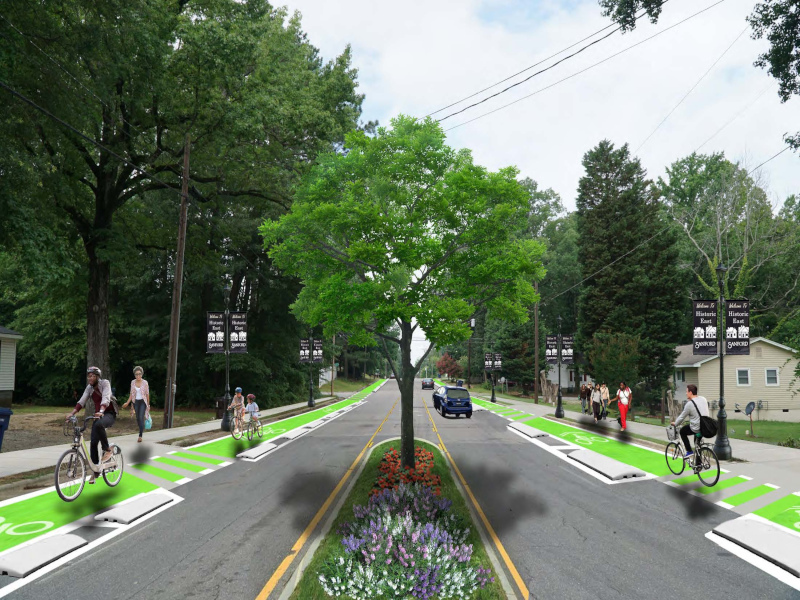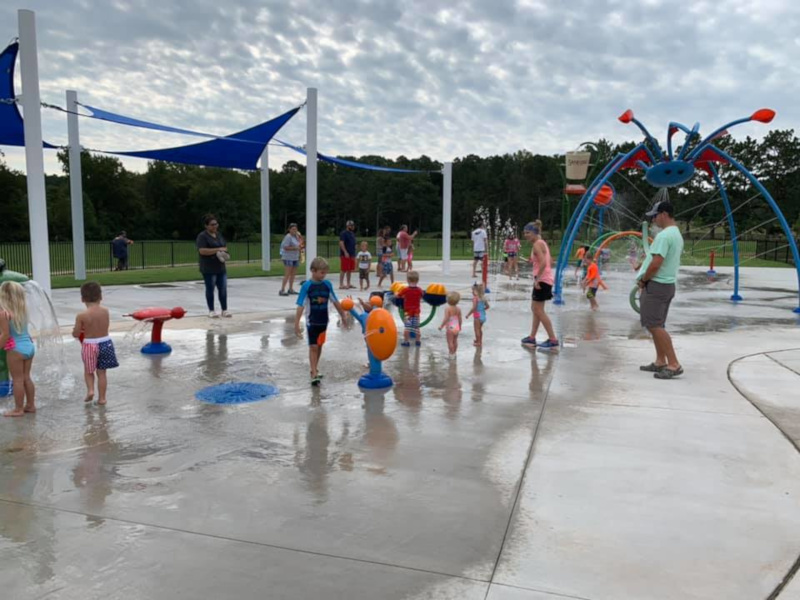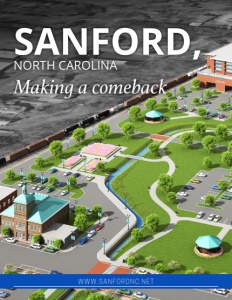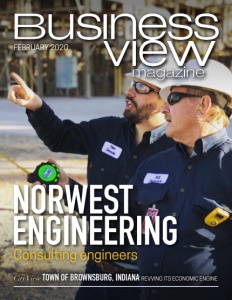Sanford, North Carolina
Making a comeback
Business View Magazine interviews representatives from Sanford, North Carolina, as part of our series on best practices in American cities.
Sanford, North Carolina, located in the central Piedmont area of the state, is a city of approximately 30,000, and the county seat of Lee County. It was incorporated in 1874, and named after C.O. Sanford, a railroad engineer who was instrumental in the building of the rail lines through the area. Because Sanford sits where white beach sand from the coast meets the Piedmont clay, the city had the right ingredients to be a large producer of clay bricks. In fact, at one time, Sanford was named the “Brick Capital of the USA.” Other industries which formerly contributed to the city’s economy included textiles, furniture, and tobacco, all of which began suffering a severe decline in the 1990s – a decline that was further exacerbated by the Great Recession of the early 2000s. Lately, though, Sanford has made a significant comeback, redefining its character and charting its growth for the future.
Recently, three companies have either expanded their facilities in Sanford, moved in, or made it known that they were planning to make the city their new home. Pharmaceutical giant, Pfizer, announced plans for a state-of-the-art gene therapy manufacturing facility in Sanford as part of the company’s ongoing investment in the area. Pfizer already has approximately 650 employees in Sanford, and its new facility is expected to add around 300 new jobs.
“Project Jupiter,” concerns an as yet-to-be-named biotechnology company that is eyeing the new spec building within the 230-acre Central Carolina Enterprise Park, a public/private partnership between local government and private developers. “Because we had some forward thinking from leadership and some private stakeholders, we expect many more buildings to go into that 230-acre site,” says Sanford Mayor, Chet Mann. “Pfizer is leading the world in gene therapy research and development, and it was a $500 million expansion. But, more importantly, it’s enticing this Project Jupiter, which is another gene therapy company, to come to town. So, we may be on the verge of a gene therapy/life sciences cluster here in Sanford. And we’re very excited for what the white lab coat community might do to a small-business town like ours.”
Finally, Kalyani Bharat Forge is erecting a new facility on 77 acres just across the highway from the Central Carolina Enterprise Park. The Kalyani Group, its parent company, is an Indian-based, multi-national, conglomerate with a manufacturing footprint across India, Germany, Sweden, France, and North America, with 10,000 employees, worldwide. Kalyani Bharat Forge, a global leader in metal forming and the world’s largest forging company, is going to invest $175 million to make aluminum parts for automobiles, while hiring 465 local people.
All of this new and potential expansion, with its concomitant creation of hundreds of new jobs, has increased demand for residential home construction, as well as the revitalization of some of Sanford’s legacy neighborhoods. Director of Planning & Development, Marshall Downey, reports, “We’ve had quite a bit of interest in having larger planned communities and neighborhoods with your traditional single-family homes, but also with opportunities for townhomes and multi-family, giving our citizens choices, should they want to live here in Sanford and work at Pfizer or at one of these industrial businesses. We adopted a land-use plan a couple of years ago and have now positioned ourselves so that we feel like we can accommodate a developer’s desire to do that type of thing.”
“We’ve created about 1,500 jobs in the last two years, and we just don’t have enough new homes for sale – especially to accommodate the 765 jobs that we just announced that aren’t even here yet,” Mann explains. “So, we created a Mayor’s Residential Task Force and brought developers and builders in from surrounding regions and talked to them about our process for doing business and what would incentivize them to look at Sanford as their next location. Once we told our economic development story and convinced some of them to take a risk and come, the doors opened, and we have just announced 1,800 new home sites with one national builder, over the next five or six years. And we have created more interest in other pieces of land for private, residential development.”

Rendering of Charlotte Avenue designed by the city working with the NC Dept. of Transportation
Downey adds that in addition to attracting new businesses in order to create jobs, and then attracting developers to build new housing for the new workers, Sanford felt it equally important to reinvest in the city’s existing spaces and neighborhoods. “To that end, the council has taken on several initiatives,” he states. “Probably the most dominant is the East Sanford Initiative, which concerns a section of town that is one of the older sections and, though not in tremendous disrepair, needs some attention. The majority of that area is within an Opportunity Zone, so we are looking at a number of strategies to partner with the private sector, again, to solicit different ways to get reinvestment in that area, whether it’s through housing tax credits, or other low-income tax credits, or using the toolbox of the Opportunity Zone to generate interest in that community. So, we’re trying to look for new construction and new growth, but also trying to take care of, and promote reinvestment in, the older parts of town, as well.”
“It’s a hundred-year-old neighborhood called East Sanford, that abuts downtown and has over a thousand properties in it that have come into some disrepair,” says Mann. “We brought in a consultant, DFI (Development Finance Initiative) from the UNC School of Government, to help us understand and address our challenges and opportunities and strengths there. And we found out that this might be a much more doable project than we ever dreamed it could be. And so, we’re identifying areas inside of this large district that we can tackle.
“One of those happens to be centered around a green space, a county-owned park that’s largely unused now, but it has, probably, a hundred or more homes around it that are in good enough shape to make a start with some revitalization. We want to focus our attention on that and, maybe, come up with a theme, or a plan, to incentivize developers or investors to come in and redevelop this area into something that’s affordable, yet attractive, that would allow younger folks or working families to live there happily, enjoy the open space, and then be able to walk or ride a bike into our downtown. So, we’re excited about it and see it as about a 20-year project. We feel that’s going to be one of our next big priorities – to see if we can turn this once grand neighborhood, that’s become somewhat blighted, into another grand neighborhood in a more modern way. And I think we can pull it off, one bit at a time.”
“The residents who live there are happy there and they’re not moving out, unlike in many other communities, where these types of neighborhoods have tons of vacant properties,” Mann adds. “We don’t have that here. In fact, it’s growing twice as fast as the rest of our city, and what our study showed is that if you fix these properties up to a greater level, most of the residents there now have the ability to pay a little more in rent. So, it’s a good proposition versus many cities that have the same issues that we’re having. And we think we have a story that we can share with investors.”
Downey agrees. “We were pleasantly surprised,” he remarks. “Although the area is in disrepair and has been somewhat neglected for years, there is certainly some demand to live there. Even the consultants were pleasantly surprised because they said that, sometimes, they go into these areas and it’s quite the opposite – that one of the biggest challenges is to convince folks to want to live in these areas. And that’s not a hurdle we have; we already have that interest. So, we see a great opportunity to turn it around and move forward with that project. And we hope it would set a precedent and let the market help dictate further reinvestment in that area.”
Meanwhile, Sanford is also intent on taking on a more active role in pursuing the city’s quality of life elements. “We had hired a consultant that told us that we weren’t doing enough to serve our residents with open spaces and passive recreation,” Mann reveals. “We didn’t have enough park space, so we floated a bond referendum that passed some years back, and part of that bond was for city parks and recreation. We were able to collaborate with our county, which deeded over half an existing park within our city limits. We went in and did a $2.3 million renovation and created a huge walking trail, and an incredible, state-of-the-art playground, and one of the better splash pads that I’ve ever seen. The first weekend it opened in late August, we had over 3,000 people in a town of 30,000 people visit it. It’s been a big tourist draw, but also a quality of life amenity. This is in a park that already had a couple of miles of walking trails, so we included the new quarter-mile walking trail that will eventually connect to our downtown greenway.”
Something that has already worked very successfully in Sanford, in terms of its quality of life amenities, while continuing to serve both its residents, as well as tourists, is the city’s public art initiatives, a key element of which has been the ongoing creation of large painted murals in downtown locations, depicting important scenes from Sanford’s past. All of the murals recognize an event, or people, or a business that is no longer in existence. They were paid for with private donations, a $40,000 grant from the State of North Carolina, and a matching grant from the city.

The city’s first mural was the Sanford Spinners, a minor league ball team in the early 1940s; they were the Tobacco Road Champions three years in a row. Crash Davis (whose name inspired the character from the movie, Bull Durham) played for them for one season. The second mural was Herb Thomas and his Fabulous Hudson Hornet; he was instrumental in starting NASCAR and Hudson, the car in the movie, CARS, is modeled after his Hudson Hornet. Then there’s Silent Wings, for three glider pilots who flew during World War II, who were born and raised in Sanford, and made it back alive. The city also recognized two African-American pillars of the community – one was an educator, W.B. Wicker, and the other one was Link Boykin, who in the early 1900s had a brick business that, at one time, employed up to 100 brick masons. The Fairview Dairy mural is the first three dimensional mural in North Carolina; it’s 50 feet tall and about 60 feet long and situated on the building where the Fairview Dairy was, originally, although it’s no longer in existence.
“Public art has worked tremendously well,” Mann enthuses. “It has been such an overwhelming success that there are people lining up to sponsor and pay for murals throughout the town. And now, the county, which has its government building near downtown, has commissioned a mural on their big building and it’s going to be incredible. We have three more murals to commission, this year, and, probably, more to come in later years. And we’ve incorporated more interactive art; we have a ‘Before I Die’ wall, for example in downtown, and now we’re focusing on fixing up some of our alleys with public art, which will include statues and sculptures and not just murals; things that you can interact with. We’re going to do a sculpture that’s a love lock, where you will walk up to this feature and put locks on it that represent your love for someone else. It’s a global initiative and we’re going to be one of the only small towns in the world to have that.
“Our citizens have loved it and now there’s a mural trail and public art initiative that features an autocast. You can download a free app and hear about the history of these art pieces and murals, because they all have a historical perspective of our town. And now, a part of that vision will include schools. Students will begin taking field trips, this year, to walk the trail and learn about our history. So, it’s something that everybody has bought into. And we’re seeing more and more people in restaurants saying they just came down to see the murals that we have in Sanford. So, it’s definitely been rewarding.
“This kind of initiative lifts people’s spirits and, in Sanford, it has stretched them, culturally, to be more proud of their town, which makes it so much easier to get buy-in for other projects. It has really created the kind of vibe that you want when you want your private stakeholders to get involved with things. So, it’s really been a feeder for many other creative ideas. If you want people to live here, one of the ways that you do that is to connect people with your past and so, I think, the historical perspective of our art, especially our mural art, has unlocked our history and heritage for others to see and learn. So, that’s a good way to connect people to something that they’re not already connected to, when they make those decisions to live and work somewhere. They feel a part of something. So, I would say our public art initiative has surpassed our expectations.”
AT A GLANCE
WHO: Sanford, North Carolina
WHAT: A city of 30,000
WHERE: Lee County, North Carolina, approx. 42 miles southwest of Raleigh
WEBSITE: www.sanfordnc.net



